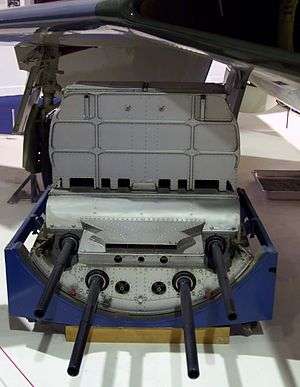ADEN cannon
| ADEN cannon | |
|---|---|
|
A quad 30 mm ADEN cannon pack removed from a Hawker Hunter | |
| Type | Revolver cannon |
| Place of origin | United Kingdom |
| Service history | |
| Used by | See users |
| Production history | |
| Designer | Armament Development Establishment |
| Designed | 1946 |
| Manufacturer | Royal Small Arms Factory |
| Produced | 1953–present |
| Specifications | |
| Weight |
Overall: 87.1 kg (192 lb 0 oz) Barrel: 12.25 kg (27 lb 0 oz) |
| Length | Overall: 1.64 m (5 ft 5 in) |
| Barrel length | 1.08 m (3 ft 7 in) |
|
| |
| Shell | 30×113mm |
| Caliber | 30 mm (1.1811 inch) caliber |
| Barrels | Single barrel (progressive RH parabolic twist, 16 grooves) |
| Action | Gas operation featuring a pneumatic cocking system and a 26 volt DC electrical firing system |
| Rate of fire | 1,200–1,700 rpm |
| Muzzle velocity | 790 m/s (2,600 ft/s) |
The Royal Small Arms Factory ADEN is a 30 mm revolver cannon used on many military aircraft, particularly those of the British Royal Air Force and Fleet Air Arm.[1] Developed post-WWII primarily to meet British Air Ministry's requirement for increased lethality in aircraft armament, the cannon was fired electrically and is fully automatic once it is loaded.[2]
Design & development
The ADEN (named for the Armament Development Establishment, where it was designed, and Enfield, where it was produced) was developed in the late 1940s as a replacement for the older Hispano-Suiza HS.404 20 mm cannon used in British aircraft of World War II. It is based (as are the French DEFA cannon and American M39 cannon) on the mechanism of the German Mauser MG 213C, an experimental revolver cannon designed for the Luftwaffe, but never used in combat. The ADEN entered service on the Hawker Hunter in 1954, and subsequently used on every British gun-armed aircraft until the advent of the Panavia Tornado in the 1980s.[1]
The current version is the ADEN Mk 4. Although its muzzle velocity of 2,592 ft/s (790 m/s) is lower than the Hispano's 2,789 ft/s (850 m/s), the substantially larger and heavier projectile makes the ADEN more lethal, and it has a higher rate of fire of about 1,300 rounds per minute.[3]
An improved version, the ADEN Mk 5, incorporates a multitude of small changes to improve reliability and increase rate of fire slightly to 1,500–1,700 rounds per minute. No new Mk 5s were built, but many older weapons were converted, being redesignated Mk 5 Straden.[3]
Aircraft using the ADEN 30 as in-built armament have included the A-4S Skyhawk, English Electric Lightning, Folland Gnat (and HAL Ajeet), Hawker Hunter, Gloster Javelin, Saab Lansen, Saab Draken, SEPECAT Jaguar, Supermarine Scimitar, and CAC Sabre. Several podded versions exist, including the installations scabbed below the fuselage of British Hawker Siddeley Harrier (and USMC AV-8A/Cs) and Sea Harriers and the Swedish FFV Aden, which is used (among others) on the BAE Hawk. The FFV Aden contains the weapon and 150 rounds of ammunition, is 151.57 in (3.85 m) long, and weighs 802.5 lb (364 kg) fully loaded.
The ADEN is very similar to the French DEFA cannon, and the two weapons use the same range of 30 mm ammunition.[1]
ADEN 25
The ADEN Mk 5 became the basis for the planned ADEN 25, which was to be a somewhat larger weapon (length: 90 inches (2,290 mm), weight: 203 pounds (92.1 kg)) firing the new range of NATO 25 mm ammunition (as in the American GAU-12 Equalizer) at a much higher muzzle velocity of 3,445 feet per second (1,050 m/s). The lighter ammunition was also to produce a higher rate of fire, 1,650 to 1,850 rounds per minute. Unfortunately, severe development problems plagued the ADEN 25, which proved unable to meet its design weight target.[4] It was finally cancelled in 1999. As a result, RAF Harrier GR.7 and GR.9 aircraft did not carry cannon, no attempt apparently having been made to retrofit the older ADEN 30 mm pods. Fleet Air Arm Sea Harriers retained the 30 mm weapon until their retirement in 2006.
Users
- Indonesian Air Force (TNI-AU)
- Royal Rhodesian Air Force (later to Air Force of Zimbabwe)
- Royal Thai Navy Flying Unit
Please note that this list is not exhaustive.
Specifications
Data from Jane's Information Group[1]
- Type: single-barrel automatic cannon
- Caliber: 30 mm (1.18 in) × 113 mm
- Operation: revolver chamber
- Length: 1.64 m (5 ft 5 in)
- Weight (complete): 87.1 kg (192 lb)
- Rate of fire: 1,200 - 1,700 rpm
- Muzzle velocity: 790 m/s (2,592 ft/s)
- Projectile weight: 220 g (7.76 oz)
See also
- DEFA cannon - Comparable French design (shares a common range of 30×113mm NATO rounds)
- Mauser BK-27 - Comparable German design
- M39 cannon - Comparable US design
References
- 1 2 3 4 Lennox, Duncan (2001). "Guns: ADEN 30 mm cannon (United Kingdom)". Jane's air-launched weapons. Jane's Information Group. ISBN 978-0-7106-0866-6.
- ↑ "Aden 30mm Gun Installation". Hawker Hunter. Retrieved 4 February 2011.
- 1 2 "ADEN 30 mm Cannon MK 4 & 5" (PDF). United Kingdom: AEI Systems Ltd. Archived from the original (PDF) on January 2, 2014. Retrieved 4 February 2011.
- ↑ http://www.forecastinternational.com/archive/disp_pdf.cfm?DACH_RECNO=1059
